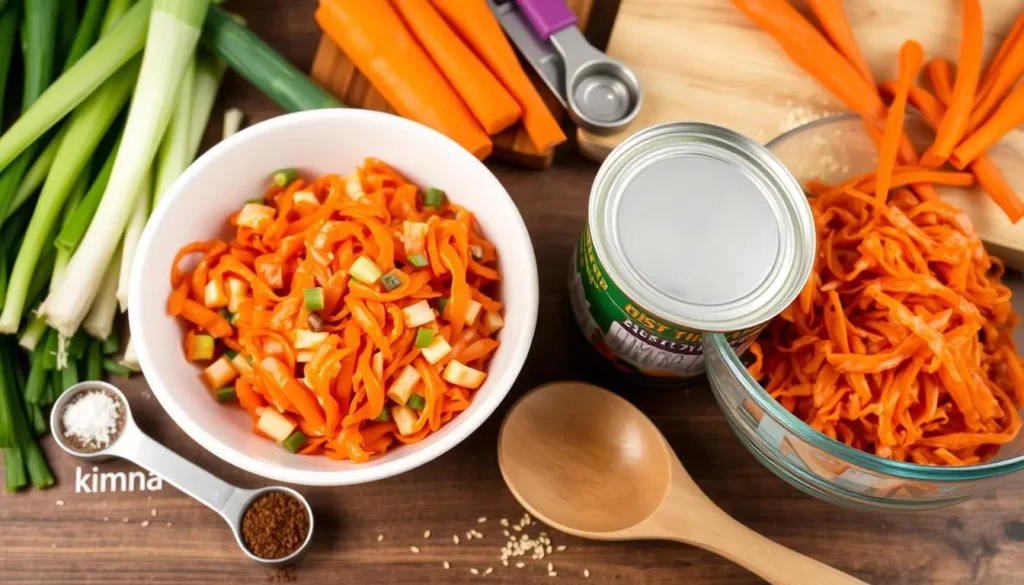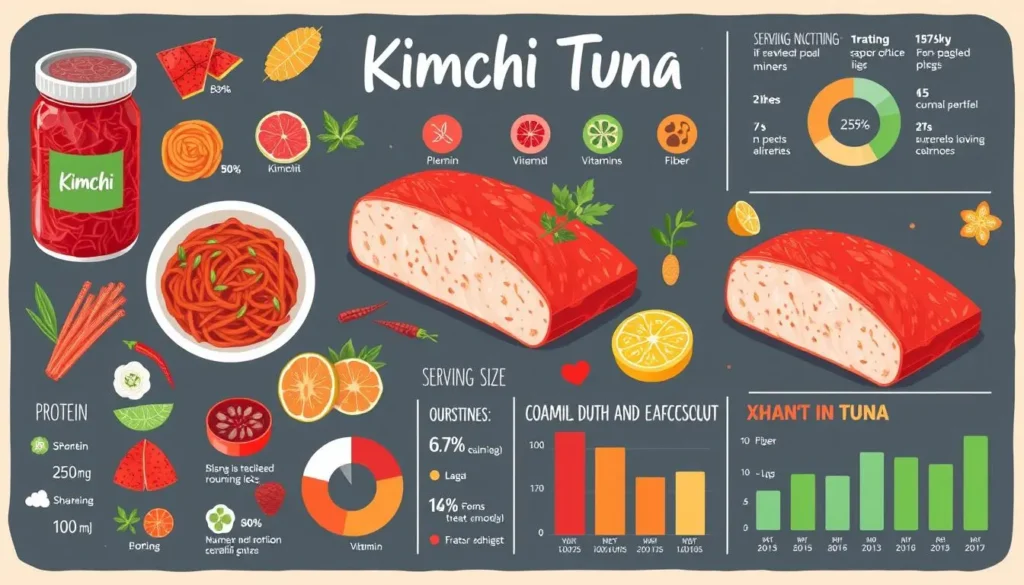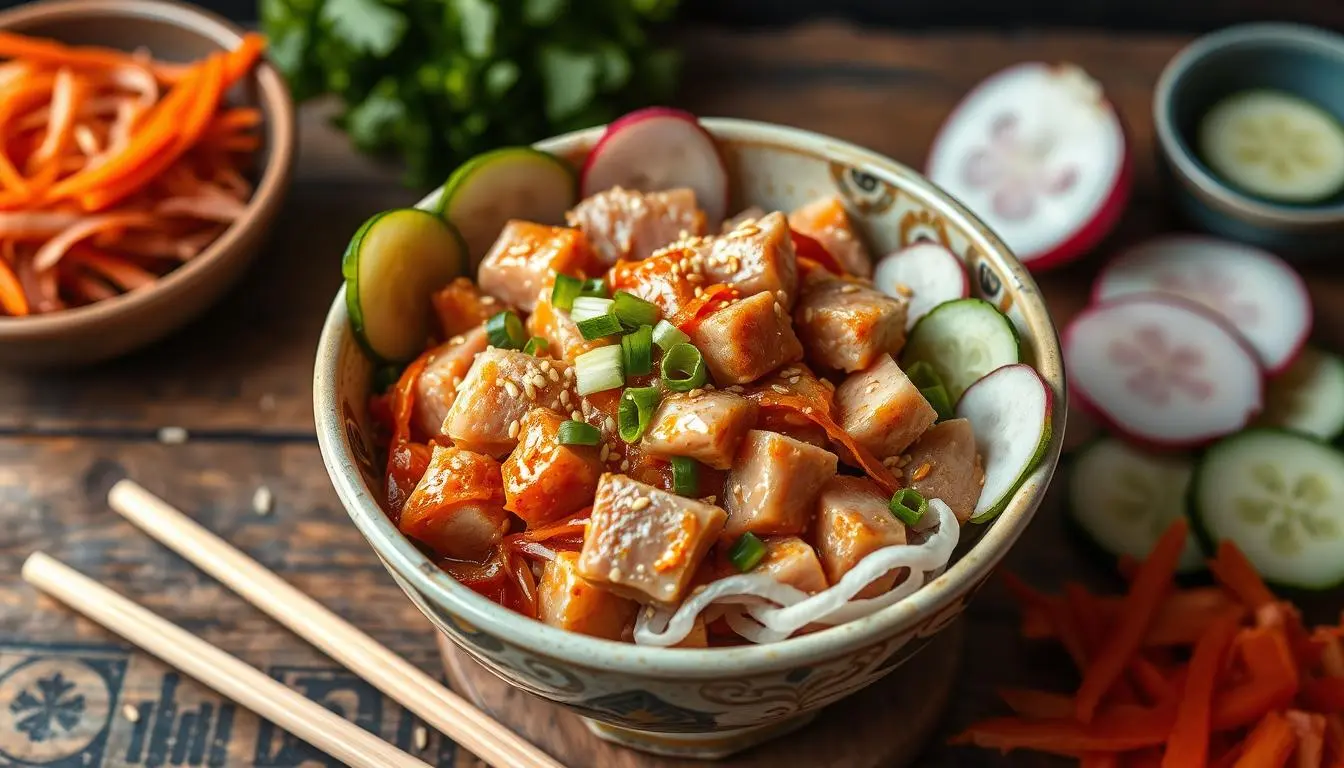Start a food journey with kimchi tuna, a mix that’s exciting many food fans. It combines the spicy kick of fermented food with tuna’s rich taste. This creates a special dish for those wanting to try new tastes.
Kimchi tuna is more than a trend. It’s loved for its mix of textures and health perks. It’s perfect for anyone wanting to explore new flavors.
- Introduction to Kimchi Tuna
- The Origin of Kimchi Tuna
- Benefits of Kimchi Tuna
- How to Make Kimchi Tuna at Home
- Key Ingredients for Authentic Kimchi Tuna
- Incorporating Kimchi Tuna into Your Meals
- Different Variations of Kimchi Tuna
- Nutritional Value of Kimchi Tuna
- Tips for Choosing the Best Ingredients
- Conclusion
- FAQ
- What exactly is kimchi tuna?
- What are the health benefits of consuming kimchi?
- Can I pair tuna with kimchi if I'm on a gluten-free or dairy-free diet?
- How do I make kimchi tuna at home?
- What are some creative ways to include kimchi tuna in my meals?
- Is kimchi tuna suitable for a high-protein diet?
- What are some variations of kimchi tuna I can try?
- How do I choose the best ingredients for my kimchi tuna?
- What is the nutritional value of kimchi tuna?
- Why is tuna a great pairing with kimchi?
Introduction to Kimchi Tuna
Kimchi Tuna is a mix of Korean and Western flavors. It combines the spicy kick of kimchi with tuna’s clean taste. This fusion is a hit with fans of both Korean and Western food.
What is Kimchi?
Kimchi is a traditional Korean dish made from fermented cabbage. It’s flavored with garlic, chili peppers, and spices. This process boosts its probiotics and makes it great for your gut.
What Makes Tuna a Great Pairing?
Tuna is high in protein and pairs well with kimchi’s bold flavors. Its mild taste balances kimchi’s tanginess, making the dish both healthy and tasty. Adding fish sauce enhances the umami, creating a perfect harmony between kimchi and tuna.
The Origin of Kimchi Tuna
The creation of kimchi tuna shows how Korean cuisine is always changing. It started with kimchi, a way to keep veggies fresh in ancient Korea. Over time, it grew to include Korean radishes and spicy flavors.
Tuna came later to Korean cooking, valued for its protein and availability. Mixing it with kimchi shows Korea’s love for new flavors.
This mix might have started recently, as people began looking for healthier food. Now, kimchi tuna is loved everywhere, showing it’s a hit globally.
To understand this mix, look at this timeline:
| Period | Development |
|---|---|
| Pre-19th Century | Kimchi first started as a way to keep veggies fresh. |
| Early 20th Century | Tuna became popular after the war for its ease and health benefits. |
| Late 20th Century | Western and Asian foods mixed, creating new dishes like kimchi tuna. |
| 21st Century | Korean food spread worldwide, with kimchi tuna being a big hit. |
This shows how Korean food is always changing. It also shows how different cultures can create amazing dishes like kimchi tuna.
Benefits of Kimchi Tuna
Kimchi tuna is packed with health benefits that make it a great nutritious meal choice. It’s perfect for many diets, including those that are gluten-free and dairy-free. Let’s look at why it’s so good for you:
Rich in Probiotics
Kimchi is famous for its probiotics, which are key for a healthy gut. The fermentation process creates good bacteria. This helps keep your gut healthy and boosts your immune system.
High Protein Content
Tuna, a main ingredient, is full of high-quality protein. This plays a crucial role in repairing and building muscles. It’s lean protein, so it doesn’t add extra calories, helping you stay healthy.
Gluten-Free and Dairy-Free Option
For people with dietary restrictions, finding good meals can be hard. Kimchi tuna is both gluten-free and dairy-free. It’s a tasty option that’s safe for many diets.
Kimchi tuna is a dish that’s good for your health and tastes great. It’s easy to fit into many diets and has a rich, savory flavor. It’s a favorite for many because it’s both nourishing and delicious.
How to Make Kimchi Tuna at Home
Making homemade kimchi tuna is fun and brings Korea’s flavors to your kitchen. You’ll need a few ingredients and some simple tips to make a dish that’s healthy and full of taste. Follow this guide to mix, season, and serve this tasty meal.
- Gather Your Ingredients: You’ll need quality canned tuna, homemade or store-bought kimchi, sesame oil, green onions, and soy sauce.
- Preparation: Drain the tuna and mix it with finely chopped kimchi in a bowl. Add a splash of sesame oil and soy sauce for an extra kick.
- Mixing: Combine all the ingredients gently to ensure the tuna does not break apart too much, maintaining some texture.
- Serving Suggestions: Serve your homemade kimchi tuna on a bed of warm rice, wrap it in seaweed for sushi rolls, or simply enjoy it as a hearty sandwich filling.

To make your homemade kimchi tuna even better, try these cooking tips:
| Tip | Detail |
|---|---|
| Kimchi Selection | Choose kimchi that is ripe and flavorful for a robust taste. |
| Tuna Texture | Opt for chunk light tuna for a more textured feel, or yellowfin tuna for a smoother blend. |
| Flavor Enhancers | Add a teaspoon of sesame seeds or a splash of fish sauce to elevate the umami in your dish. |
By using these cooking tips, your homemade kimchi tuna will taste amazing. It will also have different textures and flavors that make every bite enjoyable. Try adjusting the ingredients to match your taste, and enjoy the mix of kimchi and tuna at home.
Key Ingredients for Authentic Kimchi Tuna
To make a real kimchi tuna dish, you need the right key ingredients. These ingredients mix together to create a unique taste. They add freshness, texture, and smell to the dish. Let’s look at what makes them special.
Cabbage Kimchi
Cabbage kimchi is the main part of this dish. It gives a crunchy texture and a strong fermented taste. Choose kimchi that’s well-fermented for a deep, tangy flavor.
Tuna in Water
Using tuna in water makes the dish healthier and less oily. It works well with the kimchi, letting each ingredient stand out.
Sesame Oil and Fish Sauce
A little sesame oil and fish sauce boost the flavors of kimchi and tuna. Sesame oil adds a nutty smell and richness. Fish sauce brings out the umami, making the dish amazing.
| Ingredient | Role in Dish |
|---|---|
| Cabbage Kimchi | Provides crunch and fermented flavor |
| Tuna in Water | Offers clean, lean protein |
| Sesame Oil | Adds a rich, nutty aroma |
| Fish Sauce | Enhances depth with umami |
Incorporating Kimchi Tuna into Your Meals
Exploring meal ideas with kimchi tuna adds variety to your meals. It also boosts the nutritional integration in your diet. Kimchi tuna is versatile and adds rich flavors to many dishes, whether for breakfast, lunch, or dinner.
- Breakfast Boost: Begin with a zesty kimchi tuna omelet. It’s a protein-rich breakfast that energizes you.
- Lunch Delights: Try a kimchi tuna wrap or sandwich for a quick, nutritious meal that keeps you full.
- Dinner Specials: Add kimchi tuna to your dinner with steamed vegetables or mixed into a fresh salad for a balanced meal.
Here’s a table with popular kimchi tuna uses for your meal planning:
| Meal Type | Dish | Preparation Time | Nutritional Benefits |
|---|---|---|---|
| Breakfast | Kimchi Tuna Omelet | 10 mins | High protein, rich in omega-3 fatty acids |
| Lunch | Kimchi Tuna Salad | 15 mins | Rich in fiber, vitamins, and minerals |
| Dinner | Kimchi Tuna Stuffed Peppers | 30 mins | Low calorie, high in dietary fiber |
These meal ideas use kimchi tuna’s unique flavors. They also ensure nutritional integration in your diet. Try adding kimchi tuna to your meals for a taste of health and flavor.
Different Variations of Kimchi Tuna
Kimchi tuna variations offer a wide range of flavors. You can enjoy a zesty salad or a warm rice bowl. These dishes suit different tastes and occasions.
Kimchi Tuna Salad
The kimchi tuna salad is perfect for a light meal. It mixes the tangy kimchi with tuna’s mild flavor. Add greens, veggies, and a citrus dressing for extra freshness.
Spicy Kimchi Tuna Rice Bowl
The spicy kimchi tuna rice bowl is great for a filling meal. It combines steamed rice, spicy kimchi, and tuna. Sesame seeds and green onions add crunch and flavor.
Here’s a comparison of these dishes:
| Aspect | Kimchi Tuna Salad | Spicy Kimchi Tuna Rice Bowl |
|---|---|---|
| Main Ingredients | Tuna, kimchi, mixed greens, cucumber, carrot | Tuna, kimchi, rice, sesame seeds, green onions |
| Flavor Profile | Fresh, tangy with a bit of spiciness | Robust, spicy with umami richness |
| Best Time to Eat | Lunch, light dinner | Lunch, dinner (hearty meal) |
| Preparation Time | 15 minutes | 20 minutes |
Choose between the fresh salad or the warm rice bowl. Both offer a unique taste experience. These dishes cater to different tastes and occasions. They promise a flavorful, nutritious meal that’s quick and easy to make.
Nutritional Value of Kimchi Tuna
Kimchi tuna is a tasty dish that’s good for you. It has a low calorie content and is packed with nutrients. This makes it a great choice for a healthy diet.
Calorie Count
Kimchi tuna has few calories, which is perfect for those watching their diet. A serving has about 150-200 calories. This is thanks to the tuna’s lean protein and kimchi’s low calorie content.
Macronutrient Breakdown
Kimchi tuna is well-balanced for different diets. It has lots of protein from the tuna and fiber from the kimchi. Here’s a detailed look:
| Nutrient | Amount |
|---|---|
| Protein | 20-25g |
| Fats | 1-5g |
| Carbohydrates | 10-15g |
| Fiber | 2-3g |
This mix of nutrients helps you feel full and gives you energy for a long time.

Tips for Choosing the Best Ingredients
To make the perfect kimchi tuna dish, the quality of your ingredients matters a lot. Here’s how to pick the best ones.
Selecting the Right Kimchi
When picking kimchi, look for freshness and a deep, real flavor. Choose kimchi with bright colors and a strong, clean smell. It should be sour and spicy, showing it’s fermented well.
Make sure it’s stored in sealed containers in the fridge. This keeps it fresh. Also, check the ingredients list. The best kimchi has few, natural ingredients.
Opting for High-Quality Tuna
For tuna, freshness is essential. Whether it’s fresh or canned, it should be firm, clear, and not smell too fishy. If it’s canned, choose water or olive oil for a healthier option.
Also, pick tuna from sustainable fishing practices. This helps protect our oceans and their life.
Conclusion
Exploring new foods often leads to finding fusion cuisine that excites our taste buds. Kimchi tuna is a great choice for a unique meal that’s both tasty and healthy. This article has shown how this dish combines flavors and cultures, making it a symbol of creativity in cooking.
Kimchi tuna stands out by mixing the spicy kimchi with the fresh tuna. This mix is great for many dishes, like kimchi tuna rice bowls and salads. It’s also packed with good stuff like probiotics and protein, making it good for those watching their health.
We invite you to try making kimchi tuna at home. It’s perfect for both experienced cooks and those just starting out. Every dish has a story, and making kimchi tuna could start a new chapter in your cooking journey.
FAQ
What exactly is kimchi tuna?
Kimchi tuna is a dish that mixes spicy kimchi with tuna. It’s a healthy, tasty meal. It combines kimchi’s strong flavors with tuna’s protein.
What are the health benefits of consuming kimchi?
Kimchi is full of probiotics, which help your digestion. It also has vitamins and minerals. These can boost your immune system and lower inflammation.
Can I pair tuna with kimchi if I’m on a gluten-free or dairy-free diet?
Yes, tuna and kimchi are great for gluten-free or dairy-free diets. Just check the kimchi for gluten and choose tuna in water without dairy or gluten.
How do I make kimchi tuna at home?
To make kimchi tuna, mix canned tuna in water with kimchi. Add sesame oil and fish sauce for flavor. Mix gently to keep the textures right.
What are some creative ways to include kimchi tuna in my meals?
You can add kimchi tuna to salads or serve it over rice. It’s also good in wraps and sandwiches. It adds flavor to many dishes.
Is kimchi tuna suitable for a high-protein diet?
Yes! Tuna is full of protein, and with kimchi, it makes a filling meal. It’s perfect for those who want more protein.
What are some variations of kimchi tuna I can try?
Try a kimchi tuna salad with fresh veggies and a light dressing. Or make a spicy kimchi tuna rice bowl with avocado and seaweed for extra nutrition.
How do I choose the best ingredients for my kimchi tuna?
Choose traditional kimchi for its spice and tang. Pick high-quality tuna in water for a clean taste that goes well with kimchi.
What is the nutritional value of kimchi tuna?
Kimchi tuna is low in calories but packed with nutrients. It has proteins from tuna and vitamins and minerals from kimchi.
Why is tuna a great pairing with kimchi?
Tuna’s mild flavor complements kimchi’s bold taste. It’s also nutritious, with protein and omega-3s. This makes it a great match for kimchi.

